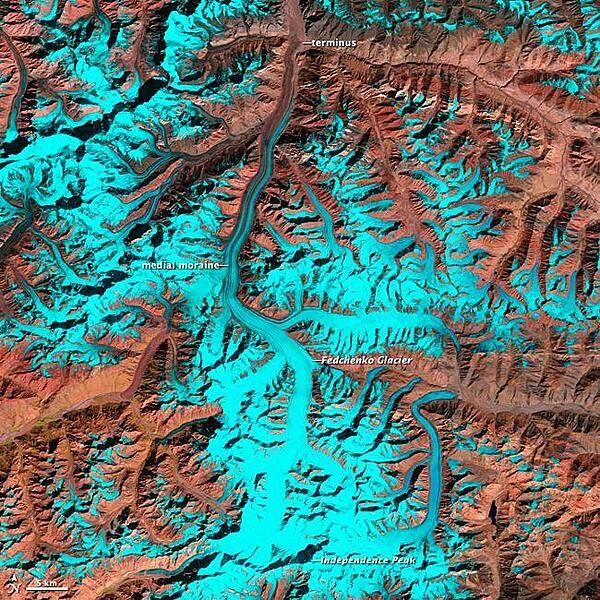Tajikistan
Photos
2 Photos
Filter Categories
All
Filters
The Pamir Mountains include some of the world's tallest peaks, soaring to heights of 7,300 m (24,000 ft ). Centered in eastern Tajikistan, the Pamirs - part of the 'roof of the world' - are home to thousands of glaciers. Among them is Fedchenko, which at 77 km (47 mi) is the longest glacier outside of the Earth's polar regions. The melt waters of Fedchenko Glacier feed into the Muksu, Vakhsh, and Amu Darya Rivers before eventually making their way to the Aral Sea some 2,000 km (1,200 mi) away. In arid central Eurasia, the snow- and glacier-covered mountains serve as the region's water towers. Nearly 90% of the Central Eurasian population relies on water from the mountains for energy, agricultural, and drinking purposes.In this false-color image from 2 October 2011, the Fedchenko Glacier can be seen as it snakes its way northward from the western slopes of Independence Peak. The sparsely vegetated, arid mountains appear reddish-brown, while snow and ice are bright cyan. (Due to the angle of sunlight, this image may cause an optical illusion known as relief inversion.) Throughout the glacier's 77 km course, it drops 2,500 m (8,200 ft) in elevation. At the highest elevations, the glacier is snow and ice covered; but as it flows downstream, it picks up rockfall debris. Reddish-hued debris lines running parallel to the flow direction begin about midway down the glacier's length. These medial moraines widen as the glacier descends. At its terminus, the glacier is completely covered by debris. Image courtesy of NASA.

Near the center of this scene is the mountain lake Kara-Kul, located in eastern Tajikistan, high in the Pamir Mountain Range near the Afghan border. The 25-km (16-mi) diameter lake sits at an elevation of about 4,000 m (about 12,000 ft) above sea level. Kara-Kul was formed from a meteorite impact approximately 25 million years ago, leaving a crater with a rim diameter of 45 km (28 mi). Islands formed from the central uplift can be seen in the northern and southern parts of the lake. Interestingly, the Kara-Kul impact structure remained unidentified until it was discovered though studies of imagery taken from space. Photo courtesy of NASA.
